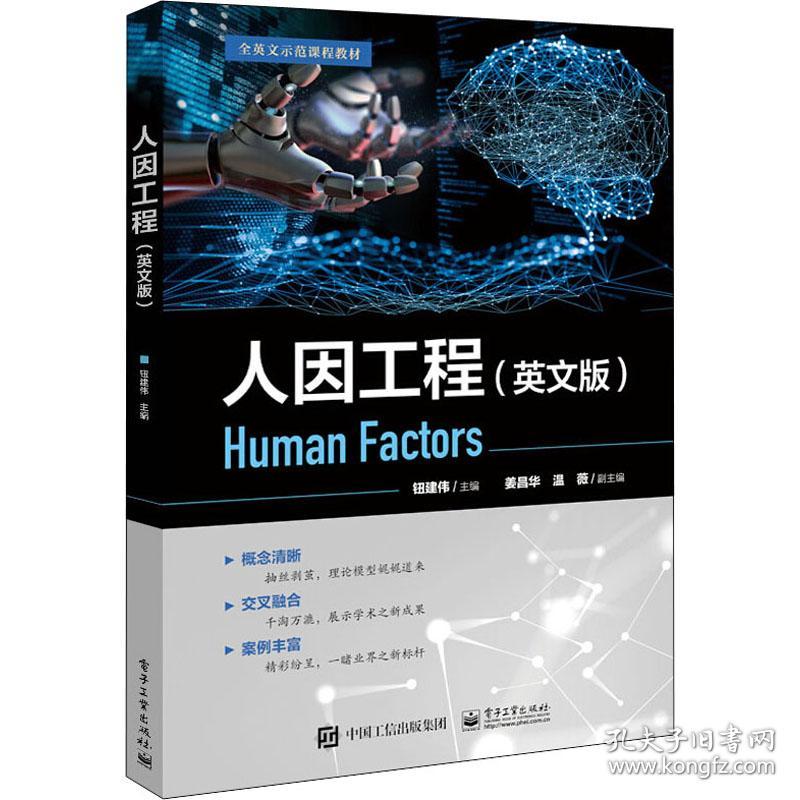
人因工程(英文版) 大中专理科电工电子 钮建伟 编
本书是编者根据近二十年从事人因工程科研的实践经验,力求全面反映人因工程的近期新发展趋势,突出理论与实践相结合、基础与前沿相结合的原则编纂而成。本书的突出特点是系统结了外相关领域的近期新与科研成果,点面结合、深入浅出,前沿而详实。书中展示的大量案例为从人因工程领域很好学术会议、知名学术期刊上经过精挑细选编纂而成,代表了该领域各细分方向国际优选学术水。读者通过本书既可以学人因工程的基本理论和基础知识,
¥ 41.05 5.9折 ¥ 69 全新
仅1件
作者钮建伟 编
出版社电子工业出版社
ISBN9787121407734
出版时间2021-03
版次1
装帧平装
开本16
页数276页
字数442千字
定价69元
货号xhwx_1202319877
上书时间2024-12-05
- 在售商品 暂无
- 平均发货时间 26小时
- 好评率 暂无
- 最新上架
商品详情
- 品相描述:全新
- 正版特价新书
- 商品描述
-
主编:
人因工程是通过人机环境系统优化来达到提高系统生产率,保证人健康、安全、舒适工作的学科。本书作者集十多年从事人因工程科研的实践经验,根据人因工程的新发展趋势,突出理论与实践相结合、基础与前沿相结合的原则编纂而成。
目录:
chapter 1 introduction to human factors 1
1.1 what is human factors 2
1.1.1 concept of human factors 2
1.1.2 domain of human factors 7
1.2 goals of human factors 11
1.3 history of human factors 14
1.3.1 the origin and development of human factors 14
1.3.2 the development of human factors in china 18
1.4 areas of ergonomics research and practice 20
1.4.1 research content 20
1.4.2 application areas 24
references 26
chapter 2 methods in human factors 27
2.1 taxonomy 28
2.2 descriptive method 30
2.2.1 scenario 30
2.2.2 variable 31
2.2.3 subjects 31
2.2.4 data collection & analysis 32
2.3 experimental method 35
2.3.1 scenario 35
2.3.2 variable 36
2.3.3 subjects 37
2.3.4 data collection & analysis 37
2.4 evaluation method 40
2.4.1 scenario 40
2.4.2 variable 41
2.4.3 subjects 42
2.4.4 data collection & analysis 42
references 46
chapter 3 anthropometry 47
3.1 what is anthropometry 48
3.2 terminology 51
3.2.1 basic ture 51
3.2.2 measurement ne 53
3.3 how dimensions measured, collected & processed 55
3.3.1 conventional methods 55
3.3.2 three dimensional (3d) anthropometry 56
3.4 applications 62
3.4.1 digital human modeling and simulation 62
3.4.2 product design for spe population 68
3.4.3 crowd simulation 71
3.4.4 virtual try-on 73
3.5 international anthropometric standards 75
references 77
chapter 4 physiology 78
4.1 structure of muscles 79
4.2 energy production 83
4.2.1 energy supply 83
4.2.2 classification of energy metabolism 85
4.3 circulatory & respiratory system 87
4.3.1 the circulatory system 87
4.3.2 the respiratory system 89
4.3.3 the connection between the respiratory system and circulatory system 91
4.4 energy expenditure 93
4.5.1 physical work capacity & energy expenditure limits 97
4.5.2 how to measure energy expenditure 97
references 101
chapter 5 fatigue & musculoskeletal disorders 102
5.1 definition 103
5.1.1 fatigue 103
5.1.2 musculoskeletal disorders 107
5.2 types 108
5.3 factors 111
5.3.1 physical factors 111
5.3.2 organizational factors, ychoso factors and individual factors 113
5.4 recovery 114
5.5 case study 116
references 117
chapter 6 occupational biomechanics 119
6.1 biomechanics & occupational biomechanics 120
6.1.1 biomechanics 120
6.1.2 occupational biomechanics 122
6.2 biomechanical models 130
6.2.1 introduction of biomechanical models 130
6.2.2 the 2d static strength model 131
6.3 low back biomechanics and manual material handling 135
6.3.1 low back biomechanics and manual material handling 135
6.3.2 niosh lifting equation 137
references 144
chapter 7 visual system 146
7.1 light 147
7.1.1 the sources of the light 147
7.1.2 color system 148
7.1.3 the visual receptor system 150
7.2 illumination 154
7.2.1 measurement of light 154
7.2.2 contrast sensitivity 155
7.3 visual perception 157
7.3.1 top-down vs. bottom-up 157
7.3.2 depth perception 158
7.4 visual search 161
7.4.1 serial search 161
7.4.2 parallel search 162
references 168
chapter 8 auditory system 169
8.1 mechanics of sound 170
8.1.1 wave, frequency, amplitude and intensity 171
8.1.2 measuring the intensity of sound 172
8.2 structure of human ear 174
8.2.1 the outer ear 174
8.2.2 the middle ear 175
8.2.3 the inner ear 175
8.3 perception of sound 177
8.3.1 loudness and pitch 177
8.3.2 sound source location 178
8.3.3 hearing loss 180
8.4 noise 182
8.4.1 assessing and controlling noise risks 183
8.4.2 hearing protection 184
8.5 case study 185
references 186
chapter 9 other perception channels 187
9.1 tactile perception 188
9.1.1 definition of tactile perception 189
9.1.2 applications of tactile perception 190
9.2 vestibular sensation 192
9.2.1 vestibular system 192
9.2.2 semicircular canal system 192
9.2.3 otolithic organs 195
9.2.4 equilibrioception 197
references 198
chapter 10 disys 200
10.1 introduction of disys 201
10.1.1 concepts of disys 201
10.1.2 the way of disys’ classification 202
10.2 disy design 203
10.2.1 principles of disy design 203
10.2.2 co schema 206
10.3 navigation disys 208
10.3.1 line table and instruction disy 209
10.3.2 ma 210
10.4 adaptive multimodal disys 215
10.4.1 multimodal interaction 215
10.4.2 adaptive multimodal disys 218
references 223
chapter 11 stress & mental workload 224
11.1 concept & sible effects of stress 226
11.2 yerkes-dodson law 227
11.3 what is mental workload 229
11.4 mental workload measurement 230
11.4.1 primary-task performance measures 230
11.4.2 secondary-task performance measures 231
11.4.3 physiological measures 234
11.4.4 subjective evaluation measures 235
references 239
chapter 12 applications in daily life 241
12.1 traditional transportation 242
12.1.1 driver information systems 242
12.1.2 advanced driver-assistance systems 245
12.1.3 autonomous cars 246
12.2 e-business 249
12.3 design for the aged 254
12.4 design for the disabled 258
references 261
内容简介:
人因工程是通过“人机环境”系统优化来达到提高系统生产率,保证人健康、安全、舒适工作的学科。通过本教材的学,使从工程的角度掌握人的生理和心理特点,对人及其与机具、环境相互关系有比较全面的了解和认识,发现并利用人的行为方式、工作能力、作业等特点,从适合人的生理与心理特征的角度出发,对工程设计、工作安排、环境布置等提出科学的建议和要求,建立一个合理可行的、实用的“人机环境”系统方案,使作业者获得舒适、健康、安全、可靠的作业环境,提高作业者的作业能力,提高生产率、安全、舒适。本书分为4个部分(基础知识、生理人因、认知人因和工程应用)共12章,主要内容包括人与人因、人因研究常用方法、人体测量、生理机能、疲劳与肌骨失调、职业生物力学、视觉系统、听觉系统、其他感知系统、视觉显示、压力与心理负荷、人因工程常应用等。本书可作为相关高校和科研院所工程、机器人工程、人工智能、智能制造、多媒体设计、车辆工程、机械工程、安全工程等相关专业双语课与全英文示范课的本科生和教材,亦可供从事汽车、航空航天、船舶、军工、机器人及办公、金融服务、娱乐环境等重大设计领域的专业人员参。
— 没有更多了 —
















以下为对购买帮助不大的评价